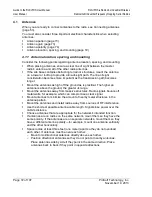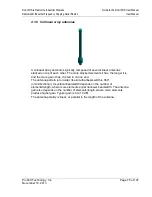
Guide to the RLX-IFHS User Manual
RLX-IFHS ♦ RadioLinx Industrial Wireless
User Manual
RadioLinx® Industrial Frequency Hopping Serial Radios
Page 62 of 107
ProSoft Technology, Inc.
November 19, 2013
3.3
Sources of Interference
The RadioLinx radio modem operates more reliably than a radio using
conventional technology due to the frequency hopping spread spectrum
technique. While RadioLinx radios are less susceptible to interference due to this
technique, interference (radio "noise") may still occur. Radios are designed to
detect specific radio frequencies. An "interferer" is an unwanted signal that has
been transmitted at the same frequency that the radio was designed to detect.
There are many man-made and natural sources of electromagnetic interference
(lightning, power lines, switching power supplies, fluorescent lighting, microwave
ovens, cordless phones, and so on). To decrease the effects of interference on
network function:
Use a directional (high gain) antenna at the Remote radio locations, if
possible
Verify that each network operating in close proximity to each other has BEEN
ASSIGNED TO A DIFFERENT CHANNEL (page 63)
Install networks in rural areas (if at all possible) where they will likely
encounter less man-made noise than in urban or suburban areas
Enable encryption
Change a radio's network output power (refer to the Radio Settings -
Transmit Power sections in the Radio Configuration (page 31) screens for
each type of network):
o
Increase
power to "drown out" competing noise
o
Decrease
power of the radios on the network if they are interfering with
another network in the vicinity
Содержание RadioLinx RLX-IFHS
Страница 6: ......






























